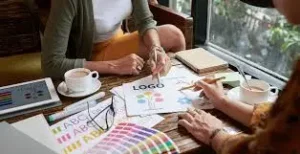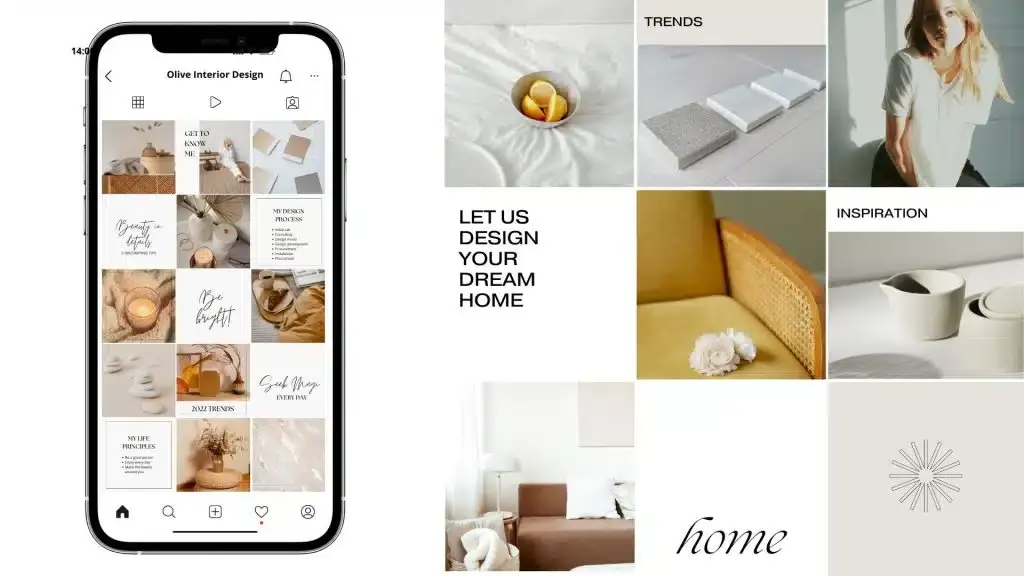Do you need help getting your next graphic design job? To be a successful graphic designer, you must learn How to Find Graphic Design Clients.
Finding and keeping clients in today’s market is tough; you need a plan and to know the trends in your field.
Graphic design is fast-paced field, and getting clients can make or break your business.
The graphic design industry is constantly evolving with new technologies and cutting-edge trends, presenting a myriad of opportunities for those who are adept at client acquisition.
Graphic designers today have to deal with a lot of problems, such as tough competition and clients’ wants that change quickly.
Still, it’s more important than ever to learn how to find and keep clients. A solid client base inspires your creativity and helps you grow and move up in your job.
According to Data USA, The workforce of Graphic designers in 2022 was 274,798 people, with 51.9% woman, and 48.1% men. The average age of male Graphic designers in the workforce is 39.7 and of female Graphic designers is 37.1, and the most common race/ethnicity for Graphic designers is White.
We’ll go over tried-and-true methods and helpful advice in this in-depth guide to help you build a solid client base.
Find out how to find your ideal clients, make a portfolio that people can’t put down, and use networking and online platforms to get good jobs.
This post will give you the tips you need to do well in today’s tough design market, whether you’re just starting out or want to move up in your field.
Are you ready to change how you get new clients? Let’s get started!
Types of graphic design clients
Knowing the different kinds of graphic design clients is important so you can tailor your approach and get meaningful jobs.
There are a few main types of clients: big clients, small businesses, startups, agencies, and individual clients.
Large-scale campaigns, branding, and internal communications are common design work for corporate clients. These clients usually have bigger funds and more complicated needs.
To improve their brand name and marketing materials, small businesses may need professional and affordable designs.
Startups are often looking for new designs to build their brand from the ground up.
This creates exciting chances for people to work together creatively. Agencies usually hire independent graphic designers to work with their own teams and take on extra work.
Finally, entrepreneurs or personal brands often want custom designs for their projects or events.
If you know about these different types of clients, you can tailor your pitch, portfolio, and marketing strategies to their needs and tastes, increasing your chances of getting good jobs.
How to get clients as a beginner graphic designer?

As a new graphic artist, it can be hard to get your first clients, but it’s not impossible if you know what to do.
Start by putting together a strong resume that looks good and shows off your best work, even if it’s from mock-ups or personal projects.
Make a professional website and use social media to show off your work and connect with people who might hire you. It’s also important to network.
To make connections and get referrals, go to local design meetups, join online groups, and participate in forums for your industry.
You could give your services at a discount or even for free in exchange for reviews and publicity.
This can help you build your credibility and bring in paying customers. You should also use freelance sites and job boards, making finding entry-level jobs easier.
Using all of these methods together will help you gain experience and build relationships with clients that will help your design job grow.
How to Find Graphic Design Clients: Tips & Strategies

Finding graphic design clients requires a strategic approach and persistence.
There are a few critical steps to this process. Let’s take a deep dive into it:
1. Understanding Your Target Market
To find good graphic design clients, you need to know your target market.
First, make a list of the qualities of your dream client. This means figuring out your field and area of expertise, like illustration, web design, or branding, so you can make your services fit the needs of a particular group of people.
When you know your niche, you can present yourself as an expert in that field, which makes it easier to get clients who need your specific skills.
Next, consider your dream clients. Are they small businesses, big companies, new companies, or non-profits?
Find out how much money they usually spend, what kind of work they need, and what design services they typically need.
With this information, you can make marketing messages and proposals more relevant to their wants.
To stay ahead of the competition, you should also consider market trends and demand.
Look at current graphic design trends, like the rising need for digital marketing assets or eco-friendly branding, to determine what the industry needs.
Find out what design services people want and ensure your services fit those needs.
Check out new businesses that are increasingly needing graphic design services.
For example, tech startups, e-commerce, and environmentally friendly companies are all growing and often need new design solutions.
By making sure your skills match these new needs, you can take advantage of new opportunities and stay relevant in a constantly changing market.
2. Building a Strong Portfolio
Making a portfolio that stands out is the most important thing you can do to get possible clients.
A varied set of projects showing off your flexibility, creativity, and technical know-how are essential to an exciting portfolio.
Include high-quality images, short and clear project descriptions, and an explanation of how you came up with each idea.
Make sure that your portfolio looks good and is easy to use. A messy or hard-to-understand style can take away from the quality of your work.
To set yourself apart from other designers, you need to showcase your unique style and skills. Figure out what makes your design style unique, whether it’s the way you use color, fonts, or new ideas.
Put more emphasis on these parts of your portfolio to substantially impact possible clients. Adding testimonials from past clients can also help build your reputation and show that you can do what you say you can.
The next important step is to market your business well. Pick the right places to show off your resumes, like Behance, Dribble, or your own website.
Each site has a different audience, so pick the ones to help you reach your goals.
Share your work and interact with more people on social media sites like Instagram, LinkedIn, and Pinterest. Using relevant hashtags and posting regularly can help you get more attention and possible clients.
Another good marketing method is to send cold emails. Do some research on possible clients, and make sure that your emails show how your skills can meet their needs.
Add a link to your resume and a short description of your work. Personalizing your emails makes it more likely that someone will respond positively.
Lastly, follow the best ways to showcase your online resume. Many clients will look at your resume on their phones, so make sure your website works well on those devices.
To give users a smooth experience, use high-resolution pictures and ensure load times are as short as possible.
Add your most recent work to your portfolio regularly to keep your skills up to date and stay active in a competitive job market.
3. Establishing your value clearly
Setting your value is one of the most important things you can do to get graphic design clients.
To do this, you need to explain what makes you different from other designers and how your skills and knowledge can help possible clients.
First, come up with your unique selling proposition (USP). This is a list of your unique skills, experiences, and the exact results you provide.
Clear this unique selling point (USP) in your online accounts, pitches, and proposals.
As much as possible, use metrics and references to show how your work has solved problems or added value for past clients. It’s also important to be clear about your prices.
List your rates and what clients get in return for their money, and stress that you’ll do great work on time and budget.
By constantly showing what you’re worth and how you can help people, you build trust and make it easier for people to see why they should hire you.
4. Networking and Building Relationships

Building relationships and networking are important steps for graphic designers who want to find business.
To use professional networks effectively, you need to connect with other pros and peers in the same field.
Join important groups on sites like LinkedIn, take part in discussions, and share your work.
Getting to know people in your field can help you get connections and work together.
One of the best ways to show off your skills and connect with possible clients or employers is through LinkedIn.
Your profile should have your portfolio and an interesting summary of your skills and experience. It should also be full and up to date.
Another great way to network is to go to events and workshops in your field.
At design conferences, you can meet possible clients, learn from experts, and stay up to date on trends in your field.
To get the most out of these events, you should learn about the people who will be there and the speakers, make a list of specific goals you want to reach, and bring business cards or digital contact information.
Use good networking techniques at the events, like starting talks with open-ended questions, paying attention, and getting in touch with new people afterward.
By making real connections with people in your field, you not only raise your profile, but you also build a support system that can help you find new chances and clients.
5. Online Presence and Branding
To get graphic design clients, it’s important to build a strong online profile and brand. Creating a good website is the most important thing you can do for your online reputation.
A graphic designer’s website should have a layout that looks good and is easy to use, a portfolio that shows off all of their best work, a “about” page that talks about their background and experience, and clear contact information.
Adding a blog where you can share your thoughts and news can also make your site more valuable.
To get possible customers, use SEO strategies like including relevant keywords in all of your content, making sure images are optimized with descriptive alt text, and making sure your site loads quickly.
Your search engine score will also go up if you keep your website mobile-friendly and add new content to it on a regular basis.
Another effective way to promote something is to use social media. Pick the social media sites that fit your work goals and the people you want to reach.
For example, Instagram and Pinterest are great for showing off your work visually, and LinkedIn is great for connecting with people in your field and possible clients. Create content strategies that will keep your audience interested.
For instance, show your audience how you design things behind the scenes, post comments from happy clients, and give them useful graphic design tips.
Using relevant hashtags, posting regularly, and interacting with fans through comments and messages can help you get a lot more attention.
By building your online presence and business in a planned way, you build a strong base that brings in and keeps clients.
6. Entering Design Contests
Entering design contests can be a great way to get clients as a graphic designer.
These contests are a great way to show off your creativity and skills to a wider audience, including potential clients looking for new talent.
Entering reputable design competitions not only adds new, difficult projects to your portfolio but also makes you more known in the design community.
Being a winner or making the shortlist in these contests can give you a lot more respect and show that you can do good work under pressure.
Design contests also often offer networking opportunities to meet possible clients, other designers, and leaders in your field.
The main goal is to win, but the publicity and experience you get from these contests can lead to new client inquiries and long-term business relationships.
By entering design contests, you show you are an active, skilled designer ready to take on new and exciting tasks.
7. Showcasing Your Work and Wins on Instagram

A fun way to get graphic design clients and build a strong online profile is to post your wins and work on Instagram.
Because Instagram is mostly pictures, it’s a great place to show off your design work in a way that is both visually appealing and interesting.
Every so often, share high-quality pictures of your finished projects, sneak peeks into how you design things, and any awards or honors you receive. You can share quick updates, tutorials, or customer reviews on Instagram Stories and Reels.
This makes your content more engaging and personal. Use important geotags and hashtags to get your posts seen by more people and attract the right people.
Getting involved with your fans by answering their comments, joining design-related conversations, and working with other designers or brands can help you get even more attention.
Drawing attention to your accomplishments and wins not only boosts your trustworthiness but also shows potential clients how you’ve grown and become more successful.
You can tell an interesting story about your professional journey on Instagram by using its features well. This will help clients see the value and skill you bring to their projects.
8. Marketing and Outreach Strategies
To find graphic design clients, you need to use effective marketing and outreach tactics. You can do a lot of good things with email marketing efforts.
To write emails that get read, you need to include clear calls to action, personalize the content to meet the needs of the receiver, and write catchy subject lines.
To get people to hire you, share excerpts from your most recent work, customer reviews, and special deals. It’s important to build and keep up an email list.
To start, get emails from people who check your website, follow you on social media, and buy from you in the past.
Lead magnets, such as free design resources or eBooks, can help you get people to sign up. Make sure you clean your list often to keep your engagement rates high.
Blogs and content marketing are two more important tactics. Writing blog posts that show off your skills not only makes you look like an expert in graphic design, but it also brings people to your website on their own.
Talk about common problems that clients have, share your thoughts on design trends, and give useful advice. Use SEO methods to get more people to see your site by finding relevant keywords and using them naturally in your writing.
To get your blog posts ranked higher in search engines, make sure they have descriptive headings, meta descriptions, and high-quality pictures.
Adding new, useful content to your blog on a regular basis keeps people interested and helps you build a loyal following.
By using email marketing, content marketing, and writing together, you can make a complete outreach plan that brings you new clients and makes your professional brand stronger.
9. Collaborating with Agencies and Influencers

Working with agencies and influential people can really help you get graphic design jobs.
When you work with marketing, advertising, or creative agencies, you can get a steady flow of jobs because these groups need good design work all the time.
Reach out to companies with your portfolio, offer to do freelance work, or work with them on pitches to build relationships.
Influencers, especially those who work in business, design, or marketing, can also help you get a lot more attention.
When you work with influencers, you can reach their already-established audience and build your reputation by being associated with them.
They could ask you to make special designs for their brand or content, take part in joint projects like webinars or social media takeovers, or write guest posts for their blogs.
These partnerships can help you get new clients and referrals, and they can also help you build your business network.
Strategically teaming up with agencies and influencers lets you use their name and reach to get more clients and build your reputation as a skilled and reliable graphic designer.
10. Freelancing Platforms and Job Boards
Job boards and sites for freelance work are great places to find graphic design clients.
To start your journey to success, find the best sites for graphic designers, such as Upwork, Fiverr, 99designs, and Behance.
Pick the platform that fits your skills and job goals, as each platform has different client needs and project types.
On these sites, it’s important to make an interesting profile. Add a professional photo, a full description of your services, and a portfolio of your best work.
Show off your unique skills, the work you’ve done for other clients, and any certifications or awards that are applicable.
Use keywords that potential clients might look for to get more people to see your profile.
You can also find good chances by using job boards and classifieds like Indeed, Glassdoor, and Craigslist. Look through these sites often for graphic design job openings.
You can narrow your search by location, job type, and field to find the best matches. It is essential to respond to job postings in a good way.
Make sure each application is tailored to the job by addressing the requirements listed, showing off your applicable experience, and including a personalized cover letter.
Include a link to your updated resume and a portfolio, and follow any other directions given in the job posting.
You can widen your search for interesting and satisfying graphic design jobs by using job boards and freelancing sites.
11. Referrals and Word-of-Mouth Marketing
If you want to find graphic design clients, using the power of word-of-mouth and recommendations can really help.
To get client recommendations, you need to figure out how to ask for them at the right time and in the right way.
After finishing a job well, ask the happy client for a referral and make it clear how much you value their help.
You can help them make good suggestions by being clear about the kind of clients you want. Making a reference program is another way to get customers to tell others about your services.
Customers who bring you new customers should get discounts, free services, or some other kind of award.
To build a reputation through word of mouth, you must regularly provide excellent service. Focus on exceeding the client’s expectations by doing great work, getting it to them on time, and communicating clearly.
Happy customers are more likely to tell others about their good experiences. Ask customers to leave feedback on Google, LinkedIn, and your website, among other places, to manage online reviews and recommendations actively.
Quickly respond to reviews, fix any issues, and thank customers for the good feedback.
Putting these testimonials on your website and social media pages can help potential clients trust you and strengthen your image as a skilled and reliable graphic artist.
By using recommendations and word-of-mouth marketing, you can build a strong network of people who will promote your business and help you attract new customers.
12. Pricing and Contract Negotiation
Setting prices and negotiating contracts are important parts of getting and keeping graphic design clients.
When you set your rates and pricing system, you need to look into the market to make sure that your prices are fair and reflect the quality of your work.
Think about things like your experience, the hard job, and the industry standards.
You could set your prices using hourly rates, fixed project fees, or value-based pricing, depending on the type of work and the client’s needs. Talk about your skills, past wins, and the benefits your clients will get from hiring you to show how valuable you are.
Being clear and sure about the value you offer helps clients see why your prices are fair and how their money will be well spent.
It is important to negotiate agreements and contracts so everyone is protected and the rules are clear. Key parts of a good contract are the project outline, deliverables, deadlines, payment terms, and any other terms that deal with changes or permissions to use the work.
Talking about these things right away can avoid mistakes and ensure that you and your client know what to expect.
If you want to negotiate well, you should be flexible but strong on the most important terms, be ready to offer alternatives if the client has a limited budget, and be ready to walk away if the terms don’t meet your needs.
Setting fair prices and professionally making contracts will help you build strong, honest relationships with clients and protect your business.
13. Continuous Learning and Adaptation
To stay competitive in the area of graphic design, which is always changing, you need to keep learning and adapting.
To keep up with changes in the industry, you should regularly use tools like design blogs, online courses, workshops, and industry conferences.
To stay up to date on the newest trends, tools, and best practices in design, you should subscribe to top design magazines, follow well-known designers on social media, and join professional networks.
As the graphic design field changes, you have to be open to new technologies and design ideas to make sure your work stays fresh and current.
Getting new skills is important for both job growth and getting new clients. You can improve your design skills and find new chances by learning new tools and techniques.
Spend some time learning how to use the newest design tools, looking into new technologies like AR/VR, or trying out different design styles.
You can also stand out from other designers by specializing in in-demand areas like UX/UI design, motion graphics, or data visualization. This will help you get clients who are looking for specific skills.
By committing to ongoing learning and skill development, you not only make your design work better, but you also show that you are a professional who is informed and flexible, ready to meet your clients’ changing needs.
Setting prices and negotiating contracts are important parts of getting and keeping graphic design clients.
When you set your rates and pricing system, you need to look into the market to make sure that your prices are fair and reflect the quality of your work.
Think about things like your experience, how hard the job is, and the standards in your industry.
You could use hourly rates, fixed project fees, or value-based pricing to set your prices depending on the type of work and what the client wants.
Show how valuable you are by talking about your skills, your past wins, and the benefits your clients will get from hiring you.
Being clear and sure about the value you offer helps clients see why your prices are fair and how their money will be well spent.
It is important to negotiate agreements and contracts so that everyone is protected and the rules are clear.
Key parts of a good contract are the project outline, deliverables, deadlines, payment terms, and any other terms that deal with changes or permissions to use the work.
By talking about these things right away, you can avoid mistakes and make sure that both you and your client know what to expect.
If you want to negotiate well, you should be flexible but strong on the most important terms, be ready to offer alternatives if the client has a limited budget, and be ready to walk away if the terms don’t meet your needs.
Setting fair prices and making contracts in a professional way will help you build strong, honest relationships with clients and protect your business.
Conclusion: How to Find Graphic Design Clients
To sum up, getting good at finding graphic design clients takes a multifaceted method that includes both long-term planning and constant work.
By figuring out who your ideal clients are and building a good portfolio, you set yourself up to get them. Making it clear what you’re worth and networking well can help you make more professional connections and find new possibilities.
Your reach grows even more when you improve your online profile with a professional website and social media marketing.
Potential clients will be able to see your skills if you enter design contests, post your work on sites like Instagram, and use marketing and outreach techniques.
Working with agencies and influencers, using freelancing platforms, and getting recommendations and word-of-mouth marketing can help you get a lot more clients.
Setting fair prices and negotiating good deals through contracts and prices is important, and you need to keep learning and adapting to stay ahead in an industry that changes quickly.
Remember that persistence and flexibility are very important. If you want to find and keep graphic design clients, you need to keep your methods up to date and stay committed to your growth.
If you found this post informative, please leave a comment below saying, “I found this post informative.”
Additionally, we encourage you to share this post with others to help educate more people.
Also, don’t forget to subscribe to our email newsletter to receive more informative content like this directly in your inbox.
FAQs: How to Find Graphic Design Clients
What are the best platforms for finding clients?
Upwork, Fiverr, 99designs, Behance, and LinkedIn are great platforms for finding graphic design clients.
How can I stand out in a competitive market?
Build a unique, high-quality portfolio, showcase your distinctive style, and consistently engage with your target audience through social media and networking.
What should I include in my portfolio?
Include a diverse range of your best work, case studies demonstrating your process, client testimonials, and a clear showcase of your skills and style.
How do I set and negotiate my rates?
Research market rates, consider your experience and project complexity, and clearly communicate the value you bring. Be prepared to discuss and adjust rates based on client needs and budget.
Where is the best place to find clients for graphic design?
Freelancing platforms, job boards, networking events, and industry-specific conferences are effective for finding clients.
How do graphic designers attract customers?
By showcasing their work through a professional portfolio, utilizing social media for promotion, engaging in content marketing, and leveraging referrals and networking.
Where is the highest demand for graphic designers?
Industries like technology, e-commerce, advertising, and entertainment often have high demand for graphic designers.











